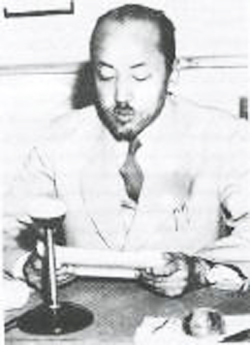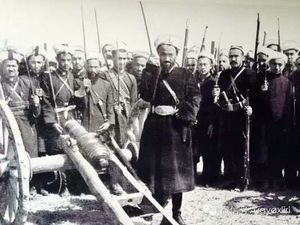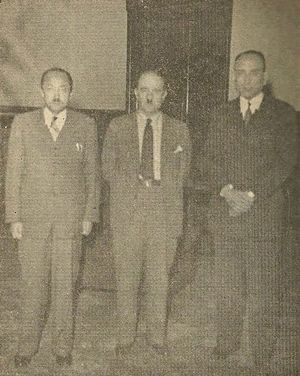محمد أمين بوغرا
| محمد أمين بوغرا | |
|---|---|

| |
| أمير جمهورية تركستان الشرقية الأولى | |
| في المنصب 1933 – April 1934 | |
| عضو الجمعية الوطنية لجمهورية الصين عن مقاطعة شينجيانگ | |
| في المنصب 1943 – - | |
| تفاصيل شخصية | |
| وُلِد | 22 أبريل 1901 خوتان |
| توفي | 29 أبريل 1965 (عن عمر 64) تركيا |
| القومية | أويغور |
| الحزب | |
| الأقارب | عبد الله بوغرا، نور أحمد جان بوغرا |
| الدين | الإسلام |
محمد أمين بوغرا (1901–1965[2]) (ويغور: مۇھەممەد ئىمىن بۇغرا) (محمد أمين بغرا), Муххамад Эмин Бугро؛ Chinese: 穆罕默德·伊敏; pinyin: Mùhǎnmòdé·Yīmǐn (وأحياناً يُكتب بالطريقة التركية: Mehmet Emin Bugra) كان زعيماً مسلماً توركياً، خطط لإقامة دولة مستقلة، جمهورية تركستان الشرقية الأولى. وكان محمد أمين بوغرا جديدياً.[3] فكان أمير جمهورية تركستان الشرقية الأولى في الفترة ما بين 12 نوفمبر 1933 إلى 6 فبراير 1934. وهو الأخ الأكبر لعبد الله بوغرا ونور أحمد جان بوغرا.
سيرته



في ربيع 1937، اندلع مرة أخرى تمردٌ في جنوب سينكيانگ. A number of factors contributed to the outbreak. In an effort to appease the Turkic Muslims, شنگ شيتساي had appointed a number of their non-secessionist leaders, including Khoja Niyaz Hajji and يولبارس خان، another leader of the Kumul uprising (February 20, 1931- November 30, 1931), to positions of influence in the provincial government, both in Di Hua (modern Ürümqi) and قشغر.
At the same time, educational reforms, which attacked basic Islamic principles, and the atheistic propaganda program, which was being extended into the south, were further alienating the local population from Sheng's administration. In Kashgar Mahmud Sijang, a wealthy Muslim, former leader of the Turpan uprising (1932), and one of Sheng's appointees, became the focal point for opposition to the government.
وفي تلك الأثناء في أفغانستان بقيادة سردار محمد هاشم خان، تواصـَل محمد أمين بوغرا، الزعيم المنفي لجمهورية تركستان الشرقية الإسلامية التوركية (TIRET، المعروفة بإسم "جمهورية تركستان الشرقية الأولى")، مع السفير الياباني في 1935 with "a detailed plan proposing the establishment of an 'Eastern Turkestan Republic' under Japanese sponsorship, with munitions and finance to be supplied by Tokyo.... he suggested as the future leader of this proposed Central Asian 'Manchukuo' none other than Mahmud Sijang (محمود محيطي - commander of the 6th Uyghur Division, stationed in Kashgar as part of the سينكيانگ provincial armed forces, since July 20, 1934), amongst the invitation at such political entity as مجال الازدهار المشترك لشرق آسيا الكبرى how active member." However, this plan was aborted when Mahmud, fearful for his life, fled from Kashgar to India on April 2, 1937, after failed attempt of شنگ شيتساي to disarm his troops by offering to " modernize " weapons of 6th Uyghur Division, prior which all old weapons of Division was to be given over to Urumchi representatives.
Mahmud's flight sparked an uprising amongst his troops against provincial authorities.[4] Those who were pro-Soviet in any way were executed, and yet another independent Muslim administration was set up under leadership of the close associate of Mahmut Muhiti General Abduniyaz (killed in action in Yarkand on August 15, 1937), who adopted a command of troops, which enlisted about 4,000 soldiers and officers, consisted of 4 regiments, two of them being stationed in Kashgar, one in Yangihissar, one in Yarkand, also one brigade was stationed in Ustin Atush and one cavalry guard escadron in Kashgar. شنگ شيتساي's provincial troops were defeated and routed by rebels in the fierce battle near city of Karashahr in July 1937, but eventually the uprising was quelled by Soviet troops (by the so-called Kyrgyz Brigade, about 5,000 troops, consisted of two tactical groups- Oshskaya and Narinskaya, each included 2 mountain regiments, one of Red Army and one of NKVD, reinforced by armoured vehicles, tank battalion (21 BT-7) and aviation; there were unconfirmed reports of the use of chemical weapons by these intervention forces against rebels), invited by شنگ شيتساي to intervene in the August, 1937.
In 1940, Muhammad Amin Bughra published the book Sharkiy Turkestan Tarihi (East Turkestan History) while in exile in Kashmir, which described the history of the region from ancient times to the present day, and contained an analysis of the reasons for the loss of its independence in the middle of the eighteenth century.[5]
In 1940 Isa Yusuf Alptekin and Ma Fuliang who were sent by Chiang Kai-shek, visited Afghanistan and contacted Bughra, they asked him to come to Chongqing, the capital of the Kuomintang regime. Bughra was arrested by the British in 1942 for spying for Japan, and the Kuomintang arranged for Bughra's release. He and Isa Yusuf worked as editors of Kuomintang Muslim publications. Under the Zhang Zhizhong regime in Xinjiang, he was provincial commissioner.[6]
Muhammad Amin Bughra and fellow Pan-Turkic Jadidist and East Turkestan Independence activist Masud Sabri rejected the Soviet imposition of the name "Uyghur people" upon the Turkic people of Xinjiang. They wanted instead the name "Turkic ethnicity" (Tujue zu in Chinese) to be applied to their people. Masud Sabri also viewed the Hui people as Muslim Han Chinese and separate from his own people.[7] The names "Türk" or "Türki" in particular were demanded by Bughra as the real name for his people. He slammed شنگ شيتساي for his designation of Turkic Muslims into different ethnicities which could sow disunion among Turkic Muslims.[8]
In December 1948, Muhammad Amin Bughra was appointed by Chiang Kai Shek as vice-chairman of the Sinkiang Government, led by Burhan Shahidi. He declared an alliance with the Chinese nationalists (Kuomintang) in order to gain autonomy for the Turkic people, under formal protection of the Republic of China, and necessity of quelling all communist forces in Sinkiang, including the Soviet backed Second East Turkestan Republic.
There were 3 Effendis, (Üch Äpändi) (ئۈچ ئەپەندى) Aisa Alptekin, Memtimin Bughra (Muhammad Amin Bughra), and Masud Sabri.[9][10] The Second East Turkestan Republic attacked them as Kuomintang "puppets".[11][12]
المنفى

Upon the approach of the Chinese People's Liberation Army to Sinkiang in September, 1949, Muhammad Amin Bughra fled to India, then to Turkey, where he joined another exiled Uyghur leader, Isa Yusuf Alptekin, former General Secretary of the National Assembly of TIRET or the First East Turkestan Republic. The latter Republic had existed a short time, from November 12, 1933, to February 6, 1934, and fell apart under attacks by the Hui armies of Ma Chung-ying, who was formally allied with the Kuomintang government in Nanking.[بحاجة لمصدر]
In 1954, Muhammad Amin Bughra and Isa Yusuf Alptekin went to Taiwan to try to persuade the Kuomintang government of the Republic of China of dropping its claims to Xinjiang. Their demand was rejected and Taiwan affirmed that it claimed Xinjiang as "an integral part of China".[13]
توفي محمد أمين بوغرا في المنفى بتركيا في 1965.[بحاجة لمصدر][استشهاد ناقص]
ذكراه
ذكرت مجلة "تركستان الإسلامية" الصادرة عن الحزب الإسلامي التركستاني في عددها الأول سيرة محمد أمين بوغرا ضمن الحديث عن تاريخ المنطقة.[14]
ملاحظات
- Mark Dickens. The Soviets in Xinjiang (1911-1949). 1990.
- Allen S. Whiting (1958) والجنرال شنگ شيتساي. Sinkiang: Pawn or Pivot ?. Michigan State University Press, USA, 1958.
- Millward, James A. (2007). Eurasian Crossroads: A History of Xinjiang (illustrated ed.). Columbia University Press. ISBN 0231139241. Retrieved 25 March 2013.
- Exploring Nationalisms of China: Themes and Conflicts. Vol. Volume 102 of Contributions to the Study of World History Series. Greenwood Publishing Group. 2002. ISBN 0313315124. Retrieved 25 March 2013.
{{cite book}}:|volume=has extra text (help); Unknown parameter|editors=ignored (|editor=suggested) (help)
الهامش
- ^ Andrew D. W. Forbes (1986). Warlords and Muslims in Chinese Central Asia: a political history of Republican Sinkiang 1911-1949. Cambridge, England: CUP Archive. p. 84. ISBN 0-521-25514-7. Retrieved 2010-06-28.
- ^ Ondřej Klimeš (8 January 2015). Struggle by the Pen: The Uyghur Discourse of Nation and National Interest, c.1900-1949. BRILL. pp. 122–. ISBN 978-90-04-28809-6.
- ^ Tursun, Nabijan (December 2014). "The influence of intellectuals of the first half of the 20th century on Uyghur politics". Uyghur Initiative Papers. Central Asia Program (11): 2–3. Archived from the original on 2016-10-12.
{{cite journal}}: Unknown parameter|deadurl=ignored (|url-status=suggested) (help) - ^ "Moslems in Chinese Turkestan in Revolt Against Pro-Soviet Provincial Authorities". The New York Times. 26 June 1937.
- ^ https://archive.org/details/SherqiTurkustanTarixidouTrkistanTarihi
- ^ Hsiao-ting Lin (2010). Modern China's Ethnic Frontiers: A Journey to the West. Taylor & Francis. p. 90. ISBN 0-415-58264-4. Retrieved 2010-06-28.
- ^ [1] Wei 2002, p. 181
- ^ [2] Millward 2007, p. 209
- ^ Kamalov, Ablet (2010). Millward, James A.; Shinmen, Yasushi; Sugawara, Jun (eds.). Uyghur Memoir literature in Central Asia on Eastern Turkistan Republic (1944-49). Studies on Xinjiang Historical Sources in 17-20th Centuries. Tokyo: The Toyo Bunko. p. 260.
- ^ Ondřej Klimeš (8 January 2015). Struggle by the Pen: The Uyghur Discourse of Nation and National Interest, c.1900-1949. BRILL. pp. 197–. ISBN 978-90-04-28809-6.
- ^ Ondřej Klimeš (8 January 2015). Struggle by the Pen: The Uyghur Discourse of Nation and National Interest, c.1900-1949. BRILL. pp. 241–. ISBN 978-90-04-28809-6.
- ^ David D. Wang (January 1999). Clouds Over Tianshan: Essays on Social Disturbance in Xinjiang in the 1940s. NIAS Press. pp. 28–. ISBN 978-87-87062-62-6.
- ^ Page 52, Ismail, Mohammed Sa'id, and Mohammed Aziz Ismail. Moslems in the Soviet Union and China. Translated by U.S. Government, Joint Publications Service. Tehran, Iran: Privately printed pamphlet, published as vol. 1, 1960 (Hejira 1380); translation printed in Washington: JPRS 3936, September 19, 1960.
- ^ "ماذا تعرف عن تركستان الشرقية". تركستان الإسلامية. No. العددالأول. السنة الأولي شعبان 1429 يوليو 2008 July 2008. p. ١٨.
{{cite magazine}}: Check date values in:|date=(help)
وصلات خارجية
- CS1 errors: unsupported parameter
- Articles containing Chinese-language text
- مقالات ذات عبارات بحاجة لمصادر
- Articles with incomplete citations from September 2018
- All articles with incomplete citations
- CS1 errors: extra text: volume
- مواليد 1901
- وفيات 1965
- أشخاص من خوتان
- أويغور
- حركة جديد
- حركة استقلال تركستان الشرقية
- سياسيو حزب قشغر الفتاة
- سياسيو جمهورية الصين من شينجيانگ